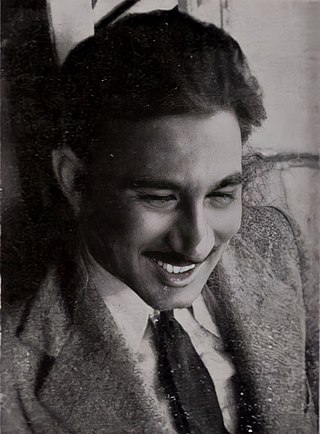
Khwaja Ahmad Abbas was an Indian film director, screenwriter, novelist, and journalist in Urdu, Hindi and English.

Urdu is an Indo-Aryan language spoken chiefly in South Asia. It is the national language and lingua franca of Pakistan, where it is also an official language alongside English. In India, Urdu is an Eighth Schedule language the status and cultural heritage of which are recognised by the Constitution of India; and it also has an official status in several Indian states. In Nepal, Urdu is a registered regional dialect and in South Africa it is a protected language in the constitution. It is also spoken as a minority language in Afghanistan and Bangladesh, with no official status.

Urdu literature comprises the literary works, written in the Urdu language. While, It tends to be dominated by poetry, especially the verse forms of the ghazal and nazm, it has expanded into other styles of writing, including that of the short story, or afsana. Urdu literature is popular mostly in Pakistan, where Urdu is the national language, and in India, where it is an Eighth Schedule language.

Nawab Mirza Khan Daagh Dehlvi was a poet known for his Urdu ghazals. He belonged to the old Delhi school of Urdu poetry.

Mysore Shrinivas Sathyu is a film director, stage designer and art director from India. He is best known for his directorial Garm Hava (1973), which was based on the partition of India. He was awarded Padma Shri in 1975.
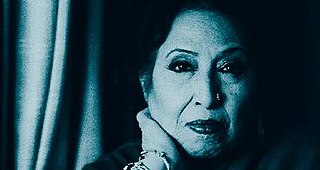
Iqbal Bano was a versatile singer who specialized in ghazal from Pakistan. She is popularly known by her honorific title Malika-e-Ghazal(The Queen of Ghazal) in both Pakistan and India. She was known for her semi-classical Urdu ghazal songs and classical thumris, but also sang easy-listening numbers in the 1950s films. In 1974, she became the recipient of the Pride of Performance award.
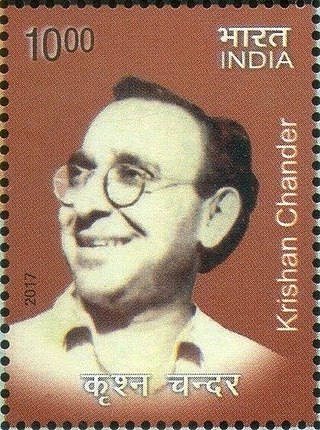
Krishan Chander was an Indian Urdu and Hindi writer of short stories and novels. Some of his works have also been translated into English. He was a prolific writer, penning over 20 novels, 30 collections of short stories and scores of radio plays in Urdu, and later, after partition in 1947, took to writing in Hindi as well. He also wrote screen-plays for Bollywood movies to supplement his meagre income as an author of satirical stories. Krishan Chander's novels have been translated into over 16 Indian languages and some foreign languages, including English.
Shama Zaidi is an Indian screenplay writer, costume designer, art director, theatre person, art critic, and documentary film maker. She is married to director M. S. Sathyu. Shama Zaidi Was Honored with Lifetime Achievement Award at ICA - International Cultural Artifact Film Festival in 2021.

Sadia Dehlvi was a Delhi-based activist, writer and a columnist with the daily newspaper, the Hindustan Times, and frequently published in Frontline and Urdu, Hindi and English newspapers and magazines. She was a devotee of Khwaja Gharib Nawaz of Ajmer and Nizamuddin Auliya of Delhi. She criticized radical interpretations of Islam and called for a pluralistic understanding of Islam. She produced and scripted documentaries and television programs, including Amma and Family (1995), starring Zohra Sehgal, a veteran stage actor.
Khushtar Girami (1902–1988) born Ram Rakha Mal Chadda, was a renowned Urdu writer and poet. He is more remembered as the editor of the then India’s leading Urdu Monthly Biswin Sadi which he also owned. He started publication of this magazine from Lahore in 1937, and later shifted to Delhi. He is credited with having introduced numerous budding Urdu and Hindi poets, short-story writers, novelists, essayists and literary critics. All renowned Urdu poets and writers were proud regular contributors to Biswin Sadi. His service to Urdu language is unforgettable. In 1977 he sold this magazine to Rehman Nayyar, the erstwhile owner and editor of Ruby, to lead a retired life. His book titled Sihat aur Zindagi published by Book Home in 1980, is a popular book on this subject.

Humayun is a 1945 Indian Hindi-language historical epic film directed by Mehboob Khan. It was the seventh highest grossing Indian film of 1945. The main cast included Ashok Kumar, Veena, Nargis as Hamida Bano, and Shah Nawaz.
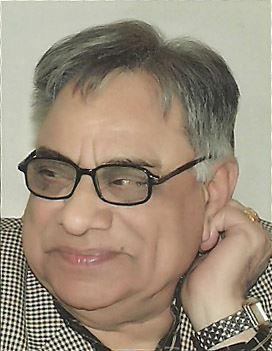
Kewal Dheer is an Indian writer and author.
Since 1940, Ilham has been a subscription-based magazine of Indo-Pak, it focuses on literature, religion, politics and youth, along with articles on current affairs. It was founded by Syed Masood Hassan Shihab in 1940 at Delhi, India.
Mehdiyan is a famous graveyard on left side of Delhi Gate, where Shah Waliullah was buried beside his father Shah Abdur Rahim. Indian freedom fighter and Islamic scholar Hifzur Rahman Seoharwi is buried in this cemetery.
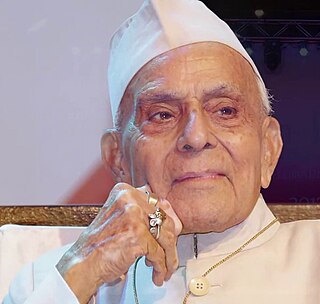
Anand Mohan Zutshi Gulzar Dehlavi was an Indian Urdu poet, scholar, and journalist. Born in old Delhi's Gali Kashmeerian.
Biswin Sadi is an Urdu language literary magazine in India. Founded in 1937, Biswin Sadi is one of the oldest Urdu magazines in India. Many of the top Urdu writers like Amrita Pritam, Kashmiri Lal Zakir, Khushwant Singh, Krishan Chander and Sahir Ludhianwi published in it. The magazine was one of the most widely read Urdu magazines, selling around 40,000 copies per issue at one point. It features content ranging from political satire, cartoons, health news to short stories.

The Urdu ghazal is a literary form of the ghazal-poetry unique to the Indian subcontinent, written in the Urdu standard of the Hindostani language. It is commonly asserted that the ghazal spread to South Asia from the influence of Sufi mystics in the Delhi Sultanate.
Major poetry related events taking place worldwide during 2020 are outlined below under different sections. This includes poetry books released during the year in different languages, major literary awards, poetry festivals and events, besides anniversaries and deaths of renowned poets etc. Nationality words link to articles with information on the nation's poetry or literature.
Shahid Ahmad Dehlvi was a Pakistani author, editor and translator. He was conferred with the Pride of Performance award for his literary services by the Government of Pakistan in 1963. He was the grandson of Urdu novel writer and religious reformer Nazir Ahmad Dehlvi.













